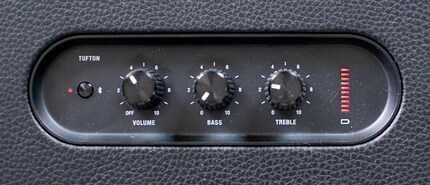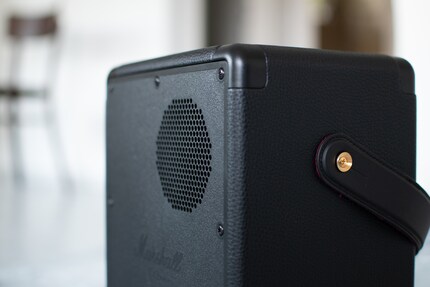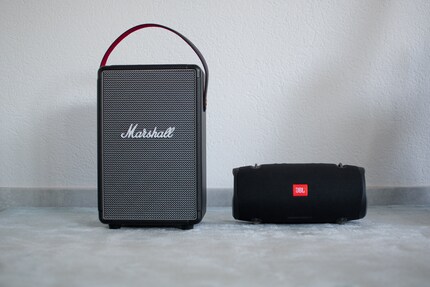
News + Trends
Knob Feel: The best review channel ever
by Dominik Bärlocher

It's great when a mobile Bluetooth speaker has powerful bass. But you can also overdo it. The Marshall Tufton has too much bass in certain environments. In others, however, it shines.
Of the three new portable Marshall speakers, the Tufton is by far the most powerful. At just under 5 kilograms, the Bluetooth lump is almost twice as heavy as the Marshall Killburn II, which our colleague Jan Johannsen tested. It contains a tweeter, mid-range and woofer on the front and another speaker for mid-range frequencies on the back.
As a guitarist, I have a soft spot for the design of Marshall speakers. But the design should also appeal to drummers, bagpipe players and false-under-the-shower singers, because it's more than just a retro gimmick. Like all Marshall speakers, the Tufton has a solid build quality and is very easy to operate. Bass and treble controls are not only practical for guitar amplifiers. Nevertheless, very few Bluetooth speakers have them.
Right, solid rotary controls are simply more fun than the annoying fiddling with buttons on many competitor products. Especially when the controls are as solidly made as they are here. How audio knobs feel is one of the most important things in life - for certain people anyway.
The simple design means that the Marshall Tufton is also simple in terms of its functions. It is not possible to pause the music on the device or skip to the next track. At least the speaker has one smart function: Thanks to Bluetooth 5.0, you can connect two smartphones or other sources at the same time and switch seamlessly between them.
The speaker switches off automatically if it is not supplied with music for some time. However, it does not switch itself on when you press play again.
The Tufton is connected to the mains using a 220V cable. The power supply unit is therefore located in the housing. According to the data sheet, the battery is fully charged in 2.5 hours. That should be about right. According to the manufacturer, the Tufton will run for at least 20 hours. That's probably not too much of a promise either. I only listened for a few hours and the battery indicator was still almost full.

Although the speaker has two midrange drivers, it is precisely these frequencies that I don't hear enough of on my first listen. This is where important things like vocals or piano would be at home. However, these elements sound strangely stifled.
It quickly becomes clear why this is the case. The bass is so dominant that it masks the mid frequencies in some pieces. In music without bass - for example, when only vocals and guitar can be heard - the mids sound very nice and clear.

Although the device has an extra bass control, I can't get the bass down enough to create a balanced sound. That really bothers me. "Nice subwoofer", I think at this moment.
However, I am doing the device an injustice, as it turns out in the further course of the test. It all depends on the environment. I first listened to the speaker in my flat. In other words, in more or less small rooms with few sound-absorbing elements. The Tufton is not suitable for this. It needs space.
I had enough space outdoors, but I didn't feel like getting on strangers' nerves right now. Instead, I tested out our video studio. It's a large room where the sound can spread quite freely. Here, it suddenly sounds completely different. I even like the sound of the Marshall Tufton in the studio better than that of the JBL Extreme 2, which I think a lot of. It was the other way round in my flat.

The Marshall Tufton is a great device. Great design, solid, easy to use, quick to charge, battery lasts a long time, and in principle it also delivers excellent sound.
But there is a catch. The bass of the Tufton is extremely dominant by nature. This is just right in some cases, but not always. The right amount of bass varies greatly depending on the environment. The speaker does have a bass control, but this cannot be turned down far enough for many situations. The device is not much good for use in small rooms.
My interest in IT and writing landed me in tech journalism early on (2000). I want to know how we can use technology without being used. Outside of the office, I’m a keen musician who makes up for lacking talent with excessive enthusiasm.